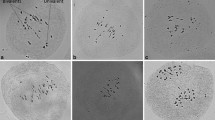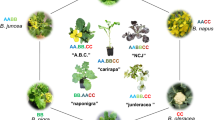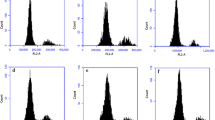Abstract
An allohexaploid Brassica crop (2n = AABBCC) does not exist naturally, but is of interest for its potential to combine useful traits found in the six cultivated Brassica species which share combinations of the A, B and C genomes with additional allelic heterosis. In this study, we aimed to produce 2n = AABBCC hybrids by crosses between B. juncea and a number of Brassica C genome species. We used ovule rescue to overcome hybridization barriers and different colchicine treatment methods to induce chromosome doubling of ABC hybrids to AABBCC allohexaploids, thus restoring fertility. Only the cross B. oleracea × B. juncea was successful, with six triploid hybrids produced from one genotype combination. Colchicine-containing regeneration media was unsuccessful in doubling chromosome number in these hybrids, but treatment of cuttings with 0.05 to 0.25% colchicine successfully produced ~ 200 S1 allohexaploid seeds. The S1 plants produced 7–84% viable pollen and set 0–390 seeds per plant, with 23–27 bivalents and 0–3 univalents during metaphase I of meiosis. Our results highlight the difficulties in working with the wild C genome species, but showed that our methods have utility for producing euploid, chromosome-doubled progeny in this cross combination. Further, Brassica oleracea × B. juncea allohexaploid hybrids may contain useful genetic factors for improved meiotic stability and fertility in allohexaploid germplasm pools.
Key message
Ovule rescue followed by 0.05–0.25% colchicine treatment of cuttings successfully produces fertile, partially stable allohexaploid Brassica from the cross B. juncea × B. oleracea.








Similar content being viewed by others
References
Angadi SV, Cutforth HW, Miller PR, McConkey BG, Entz MH, Brandt SA, Volkmar KM (2000) Response of three Brassica species to high temperature stress during reproductive growth Can J. Plant Sci 80:693–701
Arumugam N, Mukhopadhyay A, Gupta V, Pental D, Pradhan AK (1996) Synthesis of hexaploid (AABBCC) somatic hybrids: a bridging material for transfer of ‘tour’ cytoplasmic male sterility to different Brassica species. Theor Appl Genet 92:762–768
Banga SS, Bhaskar PB, Ahuja I (2003) Synthesis of intergeneric hybrids and establishment of genomic affinity between Diplotaxis catholica and crop Brassica species. Theor Appl Genet 106:1244–1247. https://doi.org/10.1007/s00122-002-1178-8
Bhat S, Sarla N (2004) Identification and overcoming barriers between Brassica rapa L. em. Metzg. and B. nigra (L.) Koch crosses for the resynthesis of B. juncea (L.) Czern. Genet Resour Crop Ev 51:455–469. https://doi.org/10.1023/B:GRES.0000024154.19867.cd
Branca F, Cartea E (2011) Brassica. In: Kole C (ed) Wild crop relatives: genomic and breeding resources. Springer, Berlin
Busso C, Attia T, Röbbelen G (1987) Trigenomic combinations for the analysis of meiotic control in the cultivated Brassica species. Genome 29:331–333
Chen LP, Zhang MF, Li CS, Hirata Y (2005) Production of interspecific somatic hybrids between tuber mustard (Brassica juncea) and red cabbage (Brassica oleracea). Plant Cell Tiss Org 80:305–311. https://doi.org/10.1007/s11240-004-2447-9
Chen L-P, Ge Y-M, Zhu X-Y (2006) Artificial synthesis of interspecific chimeras between tuber mustard (Brassica juncea) and cabbage (Brassica oleracea) and cytological analysis. Plant Cell Rep 25:907–913
Chen S et al (2011) Trigenomic bridges for Brassica improvement. Crit Rev Plant Sci 30:524–547
Chèvre AM, Barret P, Eber F, Dupuy P, Brun H, Tanguy X, Renard M (1997) Selection of stable Brassica napus-B. juncea recombinant lines resistant to blackleg (Leptosphaeria maculans). 1. Identification of molecular markers, chromosomal and genomic origin of the introgression. Theor Appl Genet 95:1104–1111
Cousin A, Heel K, Cowling WA, Nelson MN (2009) An efficient high-throughput flow cytometric method for estimating DNA ploidy level in plants. Cytometry A 75:1015–1019. https://doi.org/10.1002/cyto.a.20816
Dhooghe E, Van Laere K, Eeckhaut T, Leus L, Van Huylenbroeck J (2011) Mitotic chromosome doubling of plant tissues in vitro. Plant Cell Tissue Org 104:359–373. https://doi.org/10.1007/s11240-010-9786-5
FitzJohn RG, Armstrong TT, Newstrom-Lloyd LE, Wilton AD, Cochrane M (2007) Hybridisation within Brassica and allied genera: evaluation of potential for transgene escape. Euphytica 158:209–230
Gaebelein R, Mason AS (2018) Allohexaploids in the genus Brassica. Crit Rev Plant Sci 37:422–437
Gaebelein R, Alnajar D, Koopmann B, Mason AS (2019a) Hybrids between Brassica napus and B nigra show frequent pairing between the B and A/C genomes and resistance to blackleg. Chromosome Res. https://doi.org/10.1007/s10577-10019-09612-10572
Gaebelein R, Schiessl SV, Samans B, Batley J, Mason AS (2019b) Inherited allelic variants and novel karyotype changes influence fertility and genome stability in Brassica allohexaploids. New Phytol 223:965–978. https://doi.org/10.1111/nph.15804
Garg H, Banga S, Bansal P, Atri C, Banga SS (2007) Hybridizing Brassica rapa with wild crucifers Diplotaxis erucoides and Brassica maurorum. Euphytica 156:417–424. https://doi.org/10.1007/s10681-007-9391-9
Geng XX et al (2013) Doubled haploids of novel trigenomic Brassica derived from various interspecific crosses. Plant Cell Tiss Org 113:501–511. https://doi.org/10.1007/s11240-013-0292-4
Gupta M, Atri C, Agarwal N, Banga SS (2016) Development and molecular-genetic characterization of a stable Brassica allohexaploid. Theor Appl Genet 129:2085–2100. https://doi.org/10.1007/s00122-016-2759-2
Hilgert-Delgado A, Klima M, Viehmannova I, Urban MO, Fernandez-Cusimamani E, Vyvadilova M (2015) Efficient resynthesis of oilseed rape (Brassica napus L.) from crosses of winter types B. rapa x B. oleracea via simple ovule culture and early hybrid verification. Plant Cell Tiss Org 120:191–201. https://doi.org/10.1007/s11240-014-0593-2
Katche E, Quezada-Martinez D, Katche EI, Vasquez-Teuber P, Mason AS (2019) Interspecific hybridization for Brassica crop improvement Crop Breeding. Genet Genomics 1:e190007
Kinian SF, Quiros CF (1992) Trait inheritance, fertility, and genomic relationships of some n = 9 Brassica species. Genet Resour Crop Ev. 39:165–175
Lannér C, Bryngelsson T, Gustafsson M (1997) Relationships of wild Brassica species with chromosome number 2n = 18, based on RFLP studies. Genome 40:302–308. https://doi.org/10.1139/g97-042
Lazáro A, Aguinagalde I (1998) Genetic diversity in Brassica oleracea L. (Cruciferae) and wild relatives (2n = 18) using isozymes. Ann Bot 82:821–828. https://doi.org/10.1006/anbo.1998.0762
Li JX, Rao LL, Meng QF, Ghani MA, Chen LP (2015) Production of Brassica tri-genomic vegetable germplasm by hybridisation between tuber mustard (Brassica juncea) and red cabbage (B. oleracea). Euphytica 204:323–333. https://doi.org/10.1007/s10681-014-1336-5
Lian YJ, Lin GZ, Zhao XM, Lim HT (2011) Production and genetic characterization of somatic hybrids between leaf mustard (Brassica juncea) and broccoli (Brassica oleracea). Vitro Cell Dev 47:289–296. https://doi.org/10.1007/s11627-011-9355-6
Mallet J (2007) Hybrid speciation. Nat Rev 446:279–283
Mason AS, Yan GJ, Cowling WA, Nelson MN (2012) A new method for producing allohexaploid Brassica through unreduced gametes. Euphytica 186:277–287. https://doi.org/10.1007/s10681-011-0537-4
Mason AS et al (2015) High-throughput genotyping for species identification and diversity assessment in germplasm collections. Mol Ecol Resour 15:1091–1101. https://doi.org/10.1111/1755-0998.12379
Mei J et al (2010) Genomic relationships between wild and cultivated Brassica oleracea L. with emphasis on the origination of cultivated crops. Genet Resour Crop Ev 57:687–692. https://doi.org/10.1007/s10722-009-9504-5
Morinaga T (1934) Interspecific hybridisation in Brassica VI: The cytology of F1 hybrids of B. juncea and B. nigra. Cytologia 6:62–67
Murashige T, Skoog F (1962) A revised medium for rapid growth and bio assays with tobacco tissue cultures. Physiol Plant 15:473–497. https://doi.org/10.1111/j.1399-3054.1962.tb08052.x
Nagaharu U (1935) Genome-analysis in Brassica with special reference to the experimental formation of B. napus and peculiar mode of fertilization. Jpn J Bot 7:389–452
Pradhan A, Plummer JA, Nelson MN, Cowling WA, Yan G (2010) Successful induction of trigenomic hexaploid Brassica from a triploid hybrid of B. napus L. and B. nigra (L.). Koch Euphytica 176:87–98
Saal B, Brun H, Glais I, Struss D (2004) Identification of a Brassica juncea-derived recessive gene conferring resistance to Leptosphaeria maculans in oilseed rape. Plant Breed 123:505–511
Snogerup S, Gustafsson M, von Bothmer R (1990) Brassica sect. Brassica (Brassicaceae) I. Taxonomy and variation. Willdenowia 19:271–365
Snow AA, Moran-Palma P, Rieseberg LH, Wszelaki A, Seiler GJ (1998) Fecundity, phenology, and seed dormancy of F1 wild-crop hybrids in sunflower (Helianthus annuus, Asteraceae). Am J Bot 85:794–801. https://doi.org/10.2307/2446414
Stewart A (2004) A review of crossing relationship between cultivated Brassica species. Crucif Newslett 25:25–26
Tian E, Jiang Y, Chen L, Zou J, Liu F, Meng J (2010) Synthesis of a Brassica trigenomic allohexaploid (B. carinata × B. rapa) de novo and its stability in subsequent generations. Theor Appl Genet 121:1431–1440. https://doi.org/10.1007/s00122-010-1399-1
Tonguc M, Griffiths PD (2004) Development of black rot resistant interspecific hybrids between Brassica oleracea L. cultivars and Brassica accession A 19182, using embryo rescue. Euphytica 136:313–318. https://doi.org/10.1023/b:euph.0000032733.47031.5f
von Bothmer R, Gustafsson M, Snogerup S (1995) Brassica sect. Brassica (Brassicaceae). 2. Interspecific and intraspecific crosses with cultivars of Brassica oleracea. Genet Resour Crop Ev 42:165–178. https://doi.org/10.1007/Bf02539520
Weerakoon S (2011) Producing inter-specific hybrids between Brassica juncea (L.) Czern & Coss and B. oleracea (L.) to synthesize trigenomic (abc) Brassica. J Sci 6:13–34
Wen J et al (2012) Characterization of interploid hybrids from crosses between Brassica juncea and B. oleracea and the production of yellow-seeded B. napus. Theor Appl Genet 125:19–32. https://doi.org/10.1007/s00122-012-1813-y
Yao XC, Ge XH, Li ZY (2012) Different fertility and meiotic regularity in allohexaploids derived from trigenomic hybrids between three cultivated Brassica allotetraploids and B. maurorum. Plant Cell Rep 31:781–788. https://doi.org/10.1007/s00299-011-1200-1
Zhang GQ, Zhou WJ, Gu HH, Song WJ, Momoh EJJ (2003) Plant regeneration from the hybridization of Brassica juncea and B. napus through embryo culture. J Agron Crop Sci 189:347–350. https://doi.org/10.1046/j.1439-037x.2003.00059.x
Zhou JN, Tan C, Cui C, Ge XH, Li ZY (2016) Distinct subgenome stabilities in synthesized Brassica allohexaploids. Theor Appl Genet 129:1257–1271. https://doi.org/10.1007/s00122-016-2701-7
Acknowledgements
MWM and this project were supported by Australia-India Strategic Research Fund: Biotechnology grant AISRF06520. ASM was supported by Emmy Noether DFG grant MA6473/1-1, and DQM was supported by DFG Sino-German Centre grant MA6473/3-1. Travel and support of MG in Germany were funded by a DFG Initiation of Collaboration Grant (MA6473/10-1) and the INSA-DFG Bilateral Exchange Program-2019.
Author information
Authors and Affiliations
Contributions
MWM carried out the experiments at UWA and drafted the paper. MG undertook the cytogenetic analysis, and DQM grew the plants at JLU, collected samples and measured their fertility traits. AP assisted with multiplication and colchicine treatment of the hybrid plants at UWA. ASM assisted with writing, presentation and interpretation of the results. MWM, JB and ASM designed the experiments and JB and ASM supervised MWM.
Corresponding author
Additional information
Communicated by Ming-Tsair Chan.
Publisher's Note
Springer Nature remains neutral with regard to jurisdictional claims in published maps and institutional affiliations.
Rights and permissions
About this article
Cite this article
Mwathi, M.W., Gupta, M., Quezada-Martinez, D. et al. Fertile allohexaploid Brassica hybrids obtained from crosses between B. oleracea and B. juncea via ovule rescue and colchicine treatment of cuttings. Plant Cell Tiss Organ Cult 140, 301–313 (2020). https://doi.org/10.1007/s11240-019-01728-x
Received:
Accepted:
Published:
Issue Date:
DOI: https://doi.org/10.1007/s11240-019-01728-x




